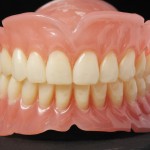
While oral health has improved complete edentulism is remains an important problem. While it is increasingly common for treatment approaches to use implant-retained prosthesis conventional complete dentures are still in widespread use. Traditional denture construction protocols involve several clinical and laboratory stages and simplified approaches have been suggested. The aim of this trial was to compare the masticatory performance and ability of a simplified technique for complete denture fabrication with a conventional technique.
Adults who had been completely edentulous for at least one year and required a new set of complete dentures were randomised to received complete dentures fabricated according to a simplified (Group S) or conventional method (Group C). The conventional method involved 6-visits the simplified method 4-visits. Masticatory performance was assessed by a colorimetric method based on an artificial test food. Masticatory ability was assessed using a five- question instrument and a visual analogue scale
- 21 patients were allocated to each group, 39 participants were assessed for three months (20 from Group C and 19 from Group S).
- There were no significant differences in masticatory performance or ability between groups C and S.
- Masticatory performance was approximately 30% of that a comparator group of dentate patients.
The authors concluded.
The simplified method for complete denture fabrication is able to restore masticatory function to a level comparable to a conventional protocol, both physiologically and according to patient’s perceptions.
Comment
Recently we noted a review by Carlsson et al ( Dental Elf 23rd Jan 2013) that suggested a single-stage impression technique may be suitable for denture construction for the majority of patients. This small study adds another small piece of evidence in relation to this.
Links
Cunha TR, Della Vecchia MP, Regis RR, Ribeiro AB, Muglia VA, Mestriner W Jr, de Souza RF. A randomised trial on simplified and conventional methods for complete denture fabrication: Masticatory performance and ability. J Dent. 2013 Feb;41(2):133-42. doi: 10.1016/j.jdent.2012.09.008. Epub 2012 Sep 19. PubMed PMID: 23000525.

I do like these studies but surely it would be beneficial to say what the simplified method is!
FF
The simple methods on both studies mentioned only used a single stage impression technique. They also only included a single stage try-in appointment.
The simplified method was:
– 1st appointment: preliminary impression by using irreversible hydrocolloid in stainless steel stock trays. Trays were previously augmented with warm utility wax strips and shaped by tongue movements and manipulation of labial and buccal soft tissues. The same movements were repeated on hydrocolloid.
– 2nd appointment: Maxillomandibular relationships transferred to wax rims as for the conventional method (please check de Souza et al. J Prosthet Dent. 2007 Jun;97(6):381-8 for details), except for the absence of facebow transfers. Adjusted maxillary rims were placed on a flat occlusal plane indicator (15° angle) and mounted in a semiadjustable articulator (by using average settings: 30° and 15° for the sagittal and lateral condylar inclinations).
– 3rd appointment: try-in after setting all artificial teeth, as usual.
– 4th appointment: denture base and occlusal adjustments, as usual.
– Post-insertion adjustments were scheduled after 1, 7 and 14 days following insertion. The number of appointments and time needed was the same for both study groups, BTW.
I hope this description will be helpful.
Regards,
Raphael (corresponding author)
Thank you for the description. I must admit I generally use a replica technique for F/F but there are occasions when it is not suitable.
[…] Dental Elf 25th Feb 2013 – Trial suggests that simplified technique for complete denture fabricati… […]
[…] Dental Elf -25th Feb- 2013 – Trial suggests that simplified technique for complete denture fab… […]
[…] Trial suggests that simplified technique for complete denture fabrication results in similar mastica… […]